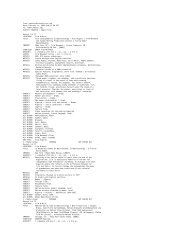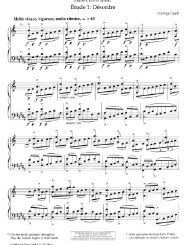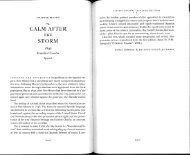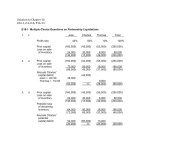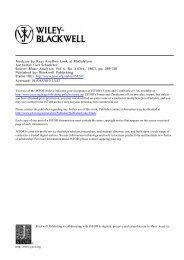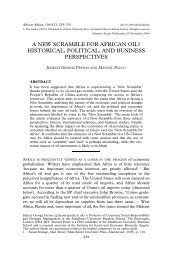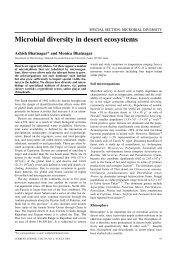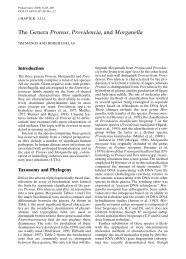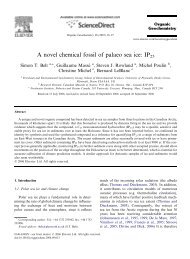The Genus Serratia
The Genus Serratia
The Genus Serratia
You also want an ePaper? Increase the reach of your titles
YUMPU automatically turns print PDFs into web optimized ePapers that Google loves.
CHAPTER 3.3.11 <strong>The</strong> <strong>Genus</strong> <strong>Serratia</strong> 237<br />
for nosocomial strains isolated in Bordeaux.<br />
Most of these S. marcescens strains gave phage<br />
susceptibility patterns that corresponded to<br />
phage types described by F. Grimont (1977);<br />
however, strains isolated in other cities of France<br />
were less often typable, and strains received<br />
from other countries were rarely typable in this<br />
system.<br />
Typing by Enzyme Electrophoresis<br />
By using agar gel electrophoresis, Grimont et al.<br />
1977a and Grimont and Grimont (1978c)<br />
detected seven different proteinases (called P 5,<br />
P 6, P 7, P 9a, P 9b, P 11, and P 12) produced by strains<br />
of S. marcescens. Each S. marcescens strain can<br />
produce one to four proteinases; 651 strains of S.<br />
marcescens, isolated over a period of six years in<br />
a French hospital, gave 33 different proteinase<br />
patterns (called zymotypes). However, six zymotypes<br />
alone accounted for 76% of the isolates.<br />
Proteinase electrophoresis was thus used as an<br />
epidemiological marker (Grimont and Grimont,<br />
1978c).<br />
Goullet (1978, 1981) showed that the <strong>Serratia</strong><br />
species were characterized by distinct electrophoretic<br />
patterns of their esterases. However,<br />
these esterase profiles were not used as epidemiological<br />
marker.<br />
Enzyme polymorphism among 99 S. marcescens<br />
isolates was determined by electrophoresis<br />
of nine enzymes (Gargallo-Viola, 1989). More<br />
than one electromorph was found for seven of<br />
these enzymes (alanine dehydrogenase, catalase,<br />
NADP-dependent malic enzyme, 6-phosphogluconate<br />
dehydrogenase, glucose-6-phosphate<br />
dehydrogenase, NADP-dependent glu- tamate<br />
dehydrogenase, and indophenol oxidase), and 33<br />
distinctive electrophoretic types. One group was<br />
represented exclusively by isolates belonging to<br />
nonpigmented biotypes recovered almost<br />
entirely (97%) from clinical samples. <strong>The</strong> other<br />
group comprised all isolates belonging to a pigmented<br />
biotype. Electrophoresis of glucose-6phosphate<br />
dehydrogenase alone can distinguish<br />
S. marcescens strains belonging to a pigmented<br />
biotype from those belonging to a nonpigmented<br />
biotype (Gargallo et al., 1987). A very good<br />
correlation was found between electrophoretic<br />
periplasmic protein patterns, enzyme electrophoresis,<br />
and biotyping by carbon source utilization<br />
(Gargallo-Viola and Lopez, 1990).<br />
Restriction Patterns<br />
Electrophoretic patterns of fragments produced<br />
after cleavage of total DNA by restriction endonucleases<br />
have been used to compare S. marcescens<br />
strains in epidemiological studies (McGeer<br />
et al., 1990).<br />
A new, generally applicable typing method has<br />
recently been proposed by Grimont and Grimont<br />
(1986) in which the DNA restriction fragments<br />
carrying rRNA genes are visualized after<br />
hybridization with a labelled E. coli 16+23S<br />
rRNA probe (rRNA gene restriction patterns).<br />
Five to seven DNA restriction fragments (after<br />
digestion by Bam HI) or 11 to 13 fragments<br />
(after digestion by EcoRI) were observed with<br />
all <strong>Serratia</strong> strains tested (Grimont and Grimont,<br />
manuscript in preparation). <strong>The</strong> different S.<br />
marcescens biogroups display different rRNA<br />
gene restriction pattern. This method should be<br />
useful in resolving occasionally uncertain (or<br />
conflicting) results given by serotyping and<br />
biotyping.<br />
Literature Cited<br />
Ackerman, L. J., Kishimoto, R. A., Emerson, J. S. 1971. Nonpigmented<br />
<strong>Serratia</strong> marcescens arthritis in a Teju (Tupinambis<br />
tequixin). American Journal of Veterinary<br />
Research 32:823–826.<br />
Alford, L. R., Holmes, N. E., Scott, W. T., Vickery, J. R. 1950.<br />
Studies on the preservation of shell eggs. Australian<br />
Journal of Applied Science 1:208–214.<br />
Altemeier, W. A., Culbertson, W. R., Fullen, W. D., McDonough,<br />
J. J. 1969. <strong>Serratia</strong> marcescens septicemia. A new<br />
threat in surgery. Archives of Surgery 99:232–238.<br />
Barnum, D. A., Thackeray, E. L., Fish, N. A. 1958. An outbreak<br />
of mastitis caused by <strong>Serratia</strong> marcescens. Canadian<br />
Journal of Comparative and Medical Veterinary<br />
Science 22:392–395.<br />
Bascomb, S., Lapage, S. P., Willcox, W. R., Curtis, M. A. 1971.<br />
Numerical classification of the tribe Klebsielleae. Journal<br />
of General Microbiology 66:279–295.<br />
Bergan, T., Grimont, P. A. D., Grimont, F. 1983. Fatty acids<br />
of <strong>Serratia</strong> determined by gas chromatography. Current<br />
Microbiology 8:7–11.<br />
Bergey, D. H., Harrison, F. C., Breed, R. S., Hammer, B. W.,<br />
Huntoon, F. M. 1923. Bergey’s manual of determinative<br />
bacteriology. Baltimore, Williams & Wilkins.<br />
Berkowitz, D. M., Lee, W. S. 1973. A selective medium for<br />
isolation and identification of <strong>Serratia</strong> marcescens.<br />
Abstracts of the Annual Meeting of the American Society<br />
for Microbiology 1973:105.<br />
Bizio, B. 1823. Lettera di Bartolomeo Bizio al chiarissimo<br />
canonico Angelo Bellani sopra il fenomeno della<br />
polenta porporina. Biblioteca Italiana o sia Giornale di<br />
Letteratura Scienze a Arti 30:275–295.<br />
Boam, G. W., Sanger, V. L., Cowan, D. F., Vaughan, D. P.<br />
1970. Subcutaneous abscesses in iguanid lizards. Journal<br />
of the American Veterinary Medical Association<br />
157:617–619.<br />
Bollet, C., Gulian, C., Mallet, M. N., Estrangin, E., de Micco,<br />
P. 1989. Isolation of <strong>Serratia</strong> rubidaea (Stapp) from fresh<br />
and spoiled coconuts. Tropical Agriculture 66:342–345.<br />
Bouvet, O. M. M., Grimont, P. A. D., Richard, C., Aldová,<br />
E., Hausner, O., Gabrhelová, M. 1985. Budvicia aquatica<br />
gen. nov., sp. nov.: a hydrogen sulfide-producing member<br />
of the Enterobacteriaceae International Journal of Systematic<br />
Bacteriology. 35:60–64.



